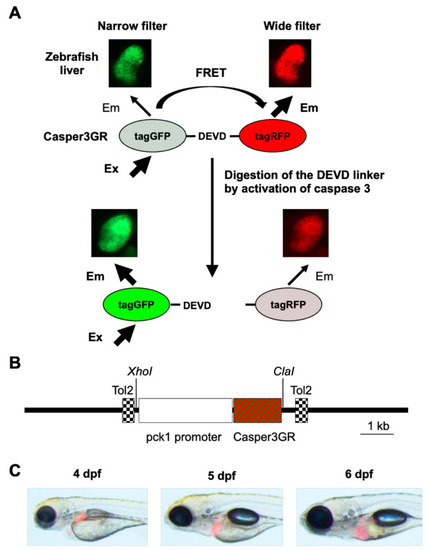Figure 1
- ID
- ZDB-FIG-211201-86
- Publication
- Higuchi et al., 2021 - Generation of a Transgenic Zebrafish Line for In Vivo Assessment of Hepatic Apoptosis
- Other Figures
- All Figure Page
- Back to All Figure Page
|
Assessment of hepatic apoptosis in zebrafish using FRET-based imaging. (A) FRET-based imaging technique developed in this study. Zebrafish expressing Casper3GR in hepatocytes were subjected to in vivo fluorescent imaging. When caspase 3 is not activated in the hepatocytes, the linker between tagGFP and tagRFP is not digested, resulting in FRET (i.e., excitation at the absorbance wavelength of tagGFP causes emission by tagRFP). When caspase 3 is activated in the hepatocytes, the linker is digested, which causes a decrease in FRET efficiency. In vivo fluorescence images of zebrafish liver obtained using a narrow filter (Ex/Em: 460–480/505–530 nm) and wide filter (Ex/Em: 460–480/567–647 nm) are also shown. (B) Diagram of the transposon vector used in this study. The coding region of Casper3GR was placed downstream of the regulatory sequences of pck1 and cloned between two Tol2 sequences in the vector backbone to direct selective protein expression in hepatocytes. (C) In vivo fluorescence imaging of Tg (pck1:Casper3GR) at 4, 5, and 6 dpf. The bright-field, GFP filter (Ex/Em: 460–490/510 nm), and RFP filter (Ex/Em: 545–580/610 nm) images are merged. |

